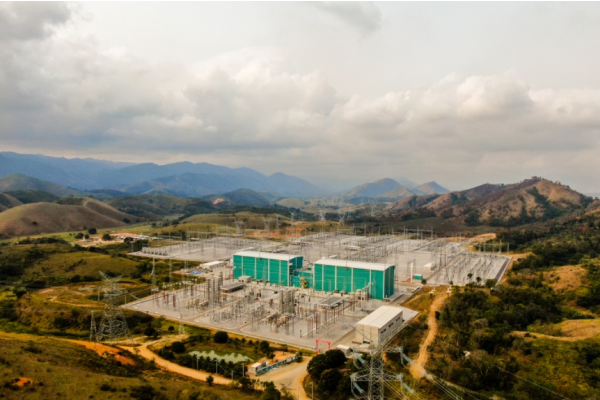Amid rolling hills near the small town of Paracambi, a three-hour drive from Rio de Janeiro, Brazil, lies a large-scale power transmission facility — the Rio converter station of the Belo Monte phase II ultra-high-voltage (UHV) transmission line project. The project was built and is managed by the State Grid Corporation of China (State Grid).

The Rio converter station of the Belo Monte phase II UHV transmission project [Photo provided by State Grid]
The Belo Monte Hydropower Plant is dubbed Brazil's "trans-century project." Eighty percent of Brazil's electricity use is in the developed southern and southeastern regions, but the hydropower resources are located in the Amazon jungle in the north, spanning over 2,000 kilometers north to south. There is a need to transmit electricity over long distances with relative low loss of power.
In February 2014, the State Grid collaborated with Brazil's Centrais Elétricas Brasileiras S.A. (Eletrobras) and won the bid for the first phase of the Belo Monte Hydropower Plant UHV DC transmission project. In July 2015, the State Grid independently won the bid for the second phase of the Belo Monte transmission project.
The Belo Monte phase II UHV transmission project starts from the Belo Monte Hydropower Plant in the Amazon River basin, crossing 81 cities and five Brazilian states, and extends to Rio de Janeiro in the southeast, covering a total length of 2,539 kilometers. It is the world's longest ±800 kV DC transmission line project.
This project transports clean hydroelectric power from northern Brazil to the load center in the southeast, creating an "electricity expressway" that benefits 22 million people, equivalent to 10 percent of the country's total population.
The Belo Monte phase II UHV transmission project covers diverse terrain, including rainforests, hills, wetlands, and grasslands. The variety of natural conditions in Brazil and differences in environmental regulations between China and Brazil raised the construction difficulty.
The project team strictly adhered to Brazilian laws and regulations on environmental protection, strengthened the conservation of animals and plants, and minimized the project's impact on the surrounding environment.
The project also proactively modified the route at 161 locations, designed over 200 tall towers, and minimized tree felling. It also established 13 animal rescue stations along the transmission line, and signed agreements for 25 plant protection stations. More than 60 experts in wildlife and flora were hired to participate in wildlife and flora protection throughout the construction period.
During construction, the project team conducted surveys on 936 species of animals, rescued 60 endangered plants, relocated 1,100 hectares of trees and grass, and invested more than BRL30 million in environmental protection.
As of February 2023, the Belo Monte project has transported over 160 billion kilowatt-hours of clean hydroelectric power, equivalent to saving over 57 million tons of standard coal and reducing carbon dioxide emissions by approximately 159 million tons. It provides robust support for Brazil's economic and social development and its transition to low-carbon energy.
In 2019, based on the evaluation criteria of the United Nations Sustainable Development Goals, the Belo Monte phase II UHV transmission project was recognized as the best social and environmental management practice in Brazil. This recognition is one of the most authoritative sustainability awards in Brazil and widely recognized in the industry. The Belo Monte transmission project is also the first large-scale power project in Brazil without environmental penalties in nearly a decade, serving as an example of being environmentally responsible and sound legal operations.
Throughout the project's construction and operation, the project team built and repaired over 1,970 kilometers of roads and 350 bridges. They conducted archaeological surveys at 4,492 locations, discovered and preserved 710 sites and natural caves, and implemented 13 social responsibility projects, helping improve the living standards of residents in impoverished communities along the line.
The project has also supported the conservation of the Valongo Wharf Archaeological Site in Rio de Janeiro, which is on the UNESCO World Heritage List, promoting the protection and inheritance of local historical and cultural heritage.
In addition, the project team has provided long-term financial assistance for a symphony orchestra in Maré that has more than 6,000 students. This assistance enabled the orchestra to take part in activities and made positive changes to the life of many children.
In October 2021, the poverty alleviation practices of the Belo Monte phase II UHV transmission project were selected as the Best Poverty Reduction Case in the Global Solicitation on Best Poverty Reduction Practices (Second Call) jointly held by the United Nations, the World Bank and other international institutions.
The successful construction and stable operation of the Belo Monte transmission project in Brazil demonstrates the positive image of Chinese enterprises, and deepens the China-Brazil friendship. It serves as a cornerstone for both sides to enhance their comprehensive strategic partnership and a model for international cooperation in electric power and energy.